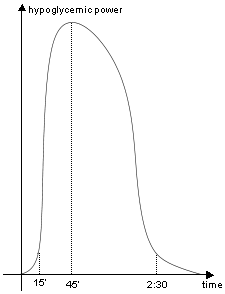Presentation
The definitions of the main words related to diabetes are given in the
terminology page, which is accessible
from the table of contents.
Context
Diabetes is a disease that concerns 2 up to 5% of population.
Despite all research works undertaken for several decades and the hope of radical treatments and even preventive solutions, this desease still only knows substitutive treatments with daily constraints, involving actively the patient.
The participation of the patient in the treatment requires a theoritical knowledge and practical know-how that necessitates what is now rederred to as "diabetes education".
This education aims a best understanding of the disease by the diabetic, and put forward the following advantages:
- insure the good comprehension of what motivates the choice of a treatment instead of another one ;
- clarify the role of dietetics ;
- specify the place of insulin treatment ;
- make the communication with medical staff easy.
Thus diabetics can take part in therapeutic discussions they are concerned in.
The ambition of our work is to assist patient in their insulin treatment and to be a support of the
diabetic education as well.
Diabetes
In the organism, glycaemia is regulated by (among other things) insulin. The latter enables organism the use of glucose, which produces a decrease of glycaemia.
There is several types of diabetes. We are going to care about type I diabetes, which affects insulin dependent diabetics (IDD). Their pancreas does not secrete insulin. So the glycaemia gets to high (hyperglycaemia). In order to cope with this phenomenon, IDD inject external insulin.
We have selected, as main factors acting on glycaemia:
- nutrition: it provides glucids required by the organism ;
- physical exercise: it leads the muscles to a consumption of glucose, and on the other hand insulin gets more efficient, so the glycaemia goes down ;
- insulin injections: they aim to balance the dysfunction of the pancreas.
Insulin treatment
As we have seen, IDD inject insulin to face pancreas dysfunction.
There is several modes of injection and several types of insuline.
Some diabetics have a permanent perfusion device: a pump worn 24 hours a day, on a belt or in a pocket.
The pumps delivers more or less large amounts of insulin located in a catheter.
The bolus dose is an amount of insulin that can be added to a continuous basal rate (eg. before meals).
Some others inject insulin by using a syringe.
To simplify, let's say that they have at one's disposal:
-
lente insulin: it has long duration (ranging from 10 up to 24 hours) but an important onset
(sometimes several hours) ;
-
regular insulin: it is a fast acting insulin (15 minutes) but lasts a short time (2 up to 6 hours).
Note : there is up to 6 types of insulin, from an ultralente insulin to a very fast acting
insulin (Humalog) that can be mixed. Diabetics usually use two types of insulin.
Moreover, we will see that criteria intervening in our insulin
modelisation can entirely be tuned.
Both types of insulin are used together. Lente insulin is injected at set times and the number of injections a day is constant (eg. an injection at 7 am and another one at 8:30 pm).
Regular insulin completes lente insulin action when a forthcoming increase of glycaemlia is foreseen, for example an increase due to a meal. The number of injections a day and the times may vary from day to day.
 |
 |
| lente insulin |
regular insulin |
| Different types of insulin |
Goals
The aim of insulin treatment is to keep glycaemia the most constant as
possible around its normal value.
Indeed, a chronic hyperglycaemia may let serious and irreversible health troubles arise.
Diabetics monitor their glycaemia during the day and, according to circumstances,
adapt their behaviour.
Depending on the result of the glycaemia measurement they either can decide to
eat suggar or inject insulin.
However, the glycaemia test is not the single parameter that should be taken into
account when determining insulin dosage.
Indeed, a low hypoglycaemia before a meal or a low hyperglycaemia before a physical
exercise do not require any injection.
On the contrary, in the case of a great hyperglycaemia when no exercise occurs,
a large amount of insulin should be injected.
Experienced diabetics can act precisely on their nutrition and forsee the implications
of their exercise in their future glycaemia variations. It enables a good self-regulation.
On the other hand, in the case of children or less careful adults, glycaemia may
fluctuate a lot.
Our goal is to provide a decision helping tool piece of software to diabetics.
During a test, the diabetic enters the current value of the glycaemia and his intents, namely:
- Is any meal planned soon ? If so, what about the glucid strength ?
- Does any exercise occurs ? Will it be intense ?
- The amount of an eventual insulin injection.
Once having entered data, the predictive system delivers a two hours forecast
of the value of glycaemia.
Thus, diabetics suffuring a lack of references are able to compare their estimations to the system
ones and change the dosage if necessary or act on meal or exercise.
Forecasts are based on generic rules established initially,
however a learning process enables to adapt the system to
the specificity of a given diabetic throughout the use.
Besides predictions, the parameters related to each decision are stored by the system.
Then the listing of these pieces of information will help the dialogue between the patients
and physicians.

